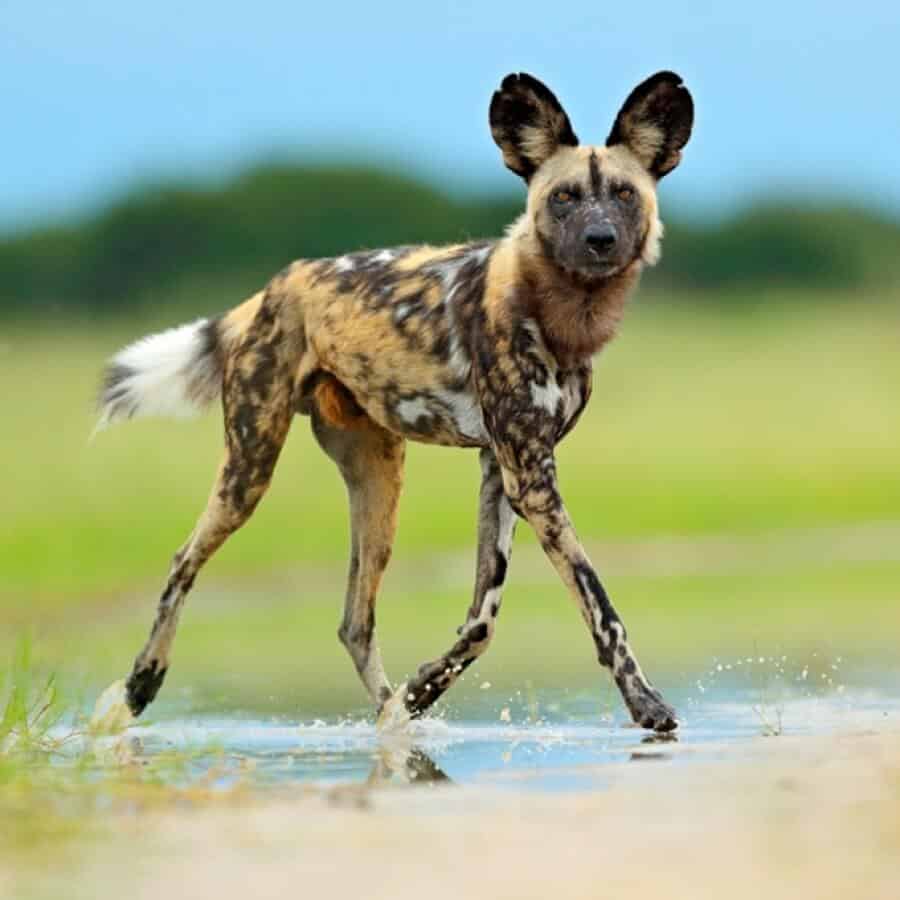Earlier in the Fantastic Beasts series, we introduced you to some the big cats of this world and provided advice on where to best see them in the wild. This week, we take a closer look at the largest canids that roam the mountains, forests and valleys across the globe.
Humankind has a millennia-long history with canids, having domesticated and bred them into all different shapes and sizes. “Man’s best friends” were originally chosen as our trusty companions due to their loyalty and ability to provide protection.
But what of their wild cousins – today’s species who share the same ancestral background as our pet pals from chihuahuas to great danes? From Africa’s endangered painted dog to the species most closely related to our trusty canine companions, the Gray Wolf, this article introduces you to the ten largest feral canids that walk the earth today!
Side-striped Jackal

In at number ten is the timid and rarely seen Side-striped Jackal. These medium-sized canids stand at 40-50 cm in height and weigh around 7-12 kg. Despite their elusive nature, these nocturnal omnivores are distributed across most of sub-Saharan Africa and are listed as least concern on the IUCN Red List. Sightings of Side-striped Jackals are rare, but for the best chances of witnessing them in their natural habitat, take a drive through Kruger National Park, South Africa after sunset.
Red Fox

The Red Fox has the widest distribution of any canid, spanning across the entire northern hemisphere and even being introduced to New Zealand and Tasmania in Australia. Reaching heights of up to half a metre and masses up to 14 kg, the Red Fox is considered the largest of all true foxes. Despite their size and omnivorous diet, the species is still too small to pose a threat to humans. For this reason, the Red Fox has benefited from the presence of human habitation, and is a common visitor to gardens in many suburban and urban areas. They can be spotted virtually anywhere within their range, but are more frequently seen after dark owing to their nocturnal nature.
Culpeo

The endangered Culpeo, or, Andean Fox is the second largest canid on the South American continent after the maned wolf. They weigh around the same as the aforementioned Red Fox, but tend to be slightly longer and taller. Larger populations can be found in open country and deciduous forests on the western slopes of the Andes. They have also been introduced to the Falkland Islands off the coast of Argentina. Head to Torres del Paine National Park in Patagonia, Chile for the best chances of seeing Culpeo in the wild.
Ethiopian Wolf

The species considered the rarest and most vulnerable of all canids, the Ethiopian Wolf is endemic to the highlands of its namesake country. Only around 400 individuals living in six fragmented populations roam the mountains of Ethiopia, making the Ethiopian Wolf Africa’s most endangered carnivore. Also known as the Abyssinian wolf, Simien fox, and cuberow, these medium-sized canids weigh up to 20 kg and can stand at over 60 cm tall. To witness these majestic creatures in their natural environment, pay a visit to Simien Mountains National Park in Ethiopia.
Dhole

Also named the Asiatic wild dog, whistling dog, red dog, and mountain wolf, Dholes are a highly social species that are native to Central, South and Southeast Asia. With a population estimated at under 2,500 adults, these diurnal pack hunters have been listed as endangered by the IUCN. Habitat loss, disease, persecution and competition with other species (including leopards and tigers) have all been contributing factors toward their decline. Dholes can reach heights of 56 cm to the shoulder and weigh up to 21 kg making them very similar in size to the Ethiopian wolf. Head to Kanha Tiger Reserve of Madhya Pradesh in India for excellent chances of spotting these canine critters in the wild.
Coyote

The Coyote is a highly versatile species that has adapted well to human modified environments. It is abundant and widely spread throughout North America southwards through Central America into Panama. The largest coyote on record measured 1.5 metres from nose to tail and weighed a whopping 34 kg! However, the most vocal of all North American mammals typically grows to sizes similar to that of the Ethiopian wolf and dhole. Many wild areas in the United States have large populations of Coyotes, including Yellowstone National Park and Rocky Mountain National Park.
Maned Wolf

The Maned Wolf boasts the title of largest canid in South America. Due to its markings, the species is known locally as aguará guazú, which means “large fox” in the Guarani language. Despite their nickname and given name, the Maned Wolf is neither a fox nor a wolf. In fact, the Maned Wolf is not is not closely related to any other member of the canid family, making the species somewhat unique. They average 23 kg in weight and stand up to 90 cm tall at the shoulder, making them the fourth largest wild canid in the world. For the best chances of spotting Maned Wolves in their natural habitat, venture to the beautiful Serra da Canastra National Park in Brazil.
African Wild Dog

Also known as the African hunting dog and painted wolf, the largest canid in Africa is a highly endangered species that has all but disappeared from much of its original range. Due to factors which include disease, human persecution and habitat fragmentation, the African Wild Dog population continues to decrease. These lean yet robust predators typically grow up to 70 cm in length and can weigh up to 30 kg. Their frames have evolved for stamina, a trait they demonstrate when chasing their prey to exhaustion. Nearly 80% of all wild dog hunts end in a kill, which is impressive considering the success rate of lions, often viewed as ultimate predators, is only 10%. Reliable areas for African Wild Dogs include Luangwa Valley, Zambia and the Okavango Delta, Botswana.
Red Wolf

Considered the rarest species of wolf in the world and one of the five most endangered canid species, the Red Wolf is listed as critically endangered by the IUCN. Also known as the Florida black wolf and Mississippi Valley wolf, they are native to the southeastern United States. Only around 50 Red Wolves now roam a confined area of just over 1.7 million acres through northeastern North Carolina. They are typically shorter and more slender than the Gray Wolf, though some specimens can grow to larger sizes than smaller sized Gray Wolves. Spotting Red Wolves in the wild can be difficult, but small populations can be found in Alligator River National Wildlife Refuge and Pocosin Lakes National Wildlife Refuge.
Gray Wolf

By far the largest of all the wild canids, the Gray Wolf, also known as the timber wolf, are the most widely distributed of all wolf species and were at one time the world’s most widely distributed mammal! One of the planet’s best known and most studied species, the Gray Wolf has been divided into many different subspecies of which five inhabit the North American continent and seven to twelve cover Eurasia. The northwestern wolf, also known as the Mackenzie Valley wolf, Alaskan timber wolf, or Canadian timber wolf is considered to be the largest of all subspecies, with specimens typically weighing 51 kg and standing at 85 cm shoulder height. To see the largest of all subspecies in the wild, head to Wood Buffalo National Park, Alberta, Canada. For excellent chances of spotting Gray Wolves, check out The Lamar Valley located in the remote northeast corner of Yellowstone National Park, United States.
Photos Shutterstock/Graphics Leigh Woods
Support us!
All your donations will be used to pay the magazine’s journalists and to support the ongoing costs of maintaining the site.
Share this post
Interested in co-operating with us?
We are open to co-operation from writers and businesses alike. You can reach us on our email at [email protected]/[email protected] and we will get back to you as quick as we can.









